Morris Minor commercials celebrate 70th anniversary
Posted by Chris Graham on 31st May 2023
Russ Harvey celebrates the 70th anniversary of the Morris Minor commercials, which were produced between 1953 and 1971, in Birmingham.
Photographs copyright of Russ Harvey
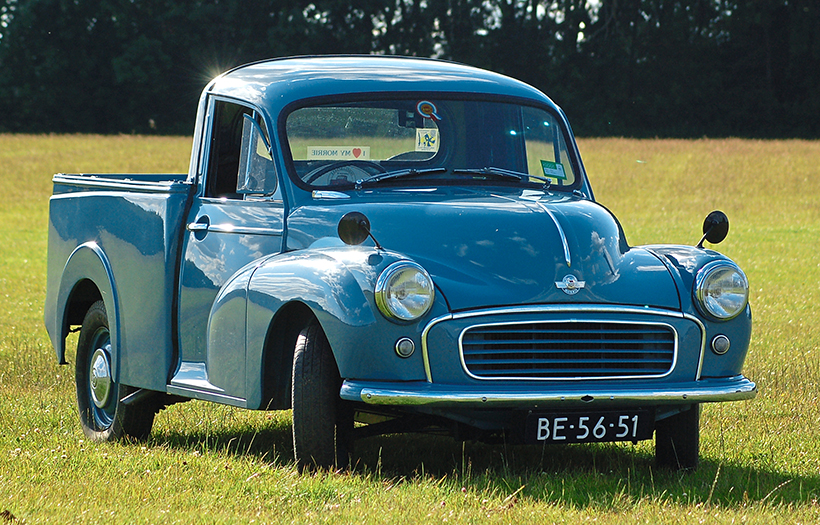
A splendid ex-Australian utility that now resides in Holland.
Minor LCVs commenced production in May 1953 at the Cowley plant, during 1960-63 some were built at Abingdon and from 1968, production was moved to the Morris Commercials plant at Adderley Park. Information from ex-BMC employees confirm that production of LCVs moved to the Nuffield Metal Products, Common Lane plant, Washwood Heath, Birmingham, which was later to become the Leyland-Daf LDV site. Minor LCVs were assembled, painted and finally trimmed at the Common Lane site, and then taken by transporters to the Adderley Park plant for fitting of the engine, transmission and rear axle ‘Nuffield Metal Products’ latter became ‘Pressed Steel Fisher’ who became part of ‘British Leyland’.
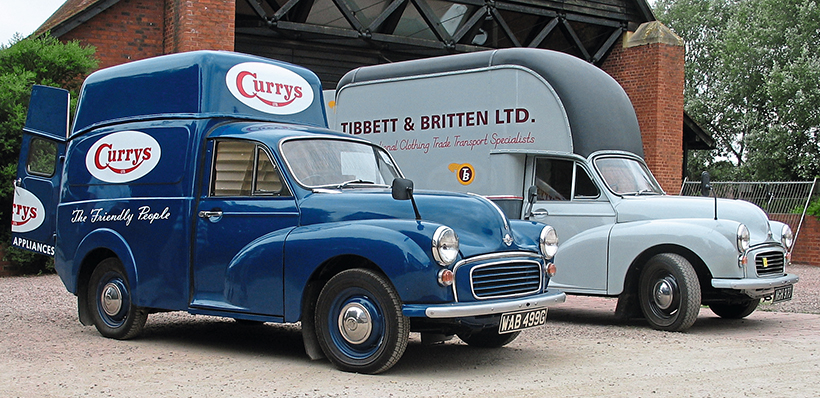
A High-Top conversion and a Gown van seen side by side at the Minor LCV Register’s 50th celebrations ten years ago during 2003.
During the 1960s and 1970s, they would have been found in every town and city in the UK. They also went to most corners of the globe, some of these vehicles had unique features to their particular country as well as their own body conversions. Most though I am sure will remember them fondly as the ‘red post van’ as well as the ‘green telephone van’, also not to mention the ‘4th emergency’ service vans used by the AA these would have arrived to rescue many a stranded motorist on a dark, wet and dismal night. Many local authorities and councils and all the major utilities often maintained large fleets in a variety of liveries. Least of all do not forget the various Police constabularies that carried differing liveries, it was not the sole domain for the Morris 1000 Panda car, both travellers and commercials were widely used.

Ian Gutherson’s Ice Cream van restored to how it was back in 1957.
The Minor LCV differed greatly from the Minor saloon range that they had derived from, they had a true box-section chassis, the cab and rear cargo area bolted on to it. The basic vehicle was supplied in one of four options a van, a pick-up or a chassis cab that came with or without a cab back panel, thus enabling the fitting of custom backs onto the chassis, for vehicles such as gown vans, high-top conversions, milk floats or even ice cream vans! Many companies today see the advantages of having a nicely signwritten vehicle for advertising and promoting their business. It also keeps the accountants happy, as all Minor LCVs are now tax-exempt!
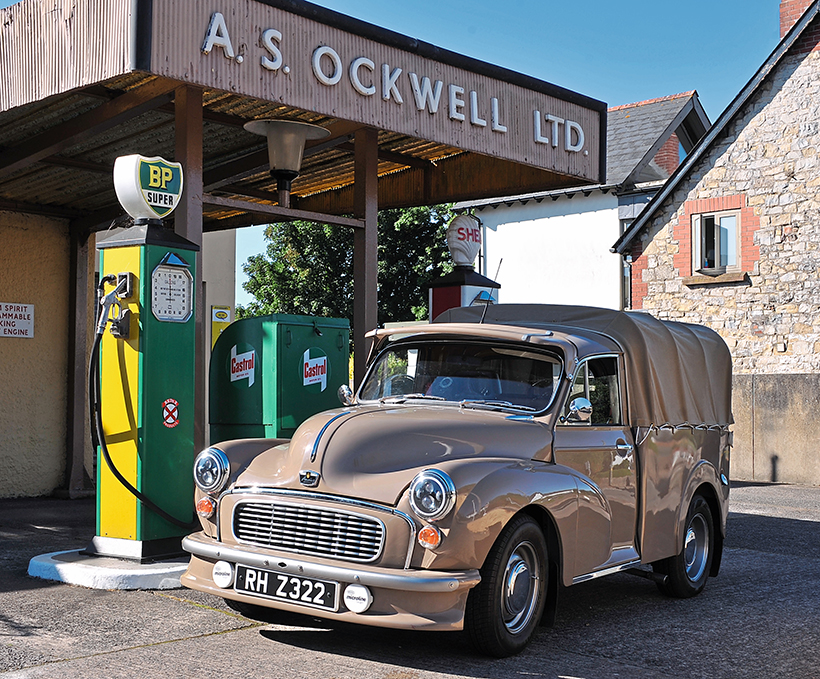
Russ Harvey’s restored Austin Minor Pick-Up.
Minor Commercials can be categorised into the ‘Series’ that were produced until production ended in 1971. The first models were known as Series IIs and were often referred to as the ‘O’ type 5 cwt, the ‘O’ from the chassis numbering system confirms the vehicle as a ¼ ton. These early vehicles were supplied with the 803cc engine. From October 1956, the Series III started to emerge with the larger 948cc, as well as many other changes in features. Under 10,000 LCVs were assembled at the Abingdon MG plant and according to folklore only 49 were pick-ups, a number of these units were, assembled on the change over from series III to V. During October 1962, the Series V appeared, the main changes that took place were the fitting of the 1098cc engine these remained in production until the end in 1971. During 1968, the C series was introduced, these were Austin Minors, basically Morris’ badged Austins!
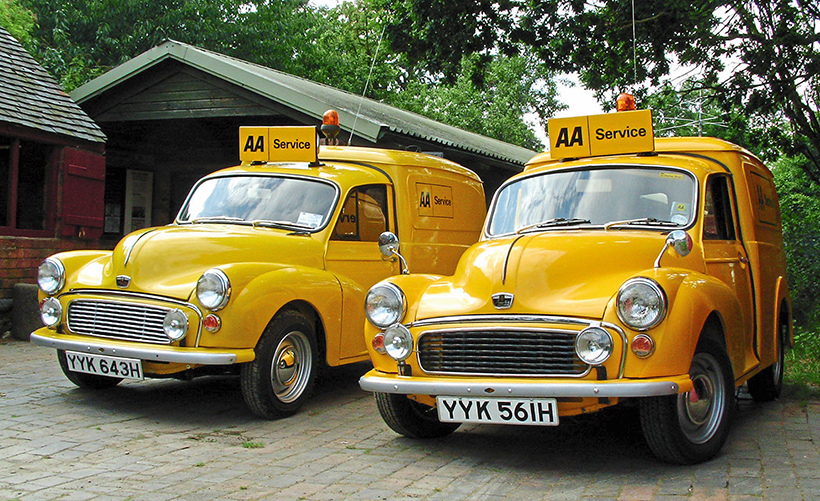
Restored ex-AA vans reunited after 30 years, seen at a Minor LCV register rally.
In chronological order are some of the changes that have taken place in production life of the Minor LCV, this is by no means exhaustive and only lists some of the important milestones. Interior varied over the years but it was available in brown, black or Arizona beige, seats and door trims were normally matched accordingly. Rubber matting covered the cab floor leaving the inners sills and wheel arches as exposed metal, the only rubber flooring variations found was within the GPO range. Headlining used on the series II and IIIs was the rigid covered board type, later replaced by a fabric version in 1957 available in two shades of grey.
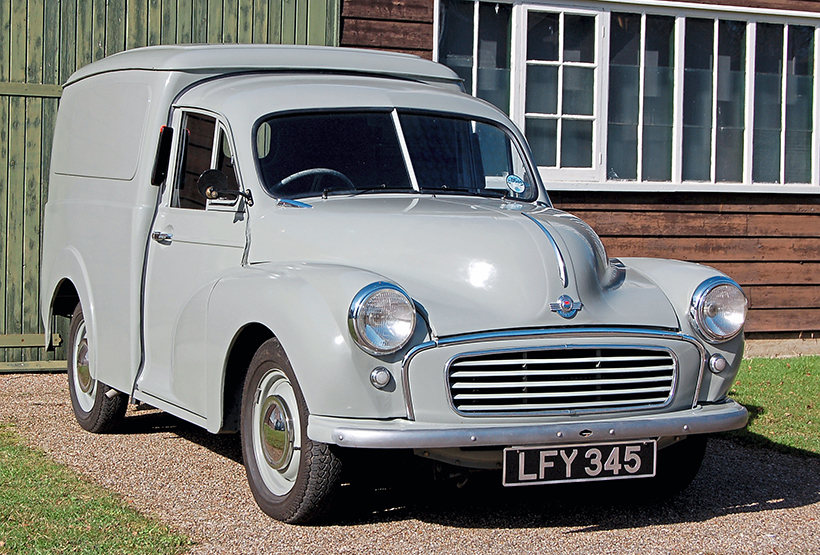
Restored 1954 series II Minor van owned by Keith Luck.
1953. First van produced with the 803cc engine it was designated as a Series II. The main difference from a saloon was the LCV has a true chassis, with telescopic rear shockers and a shorter painted front bumper blade. A chrome bonnet flash and badge from the Saloon MM type and remained in place throughout the entire LCV production. The early LCVs were supplied with fixed quarter-lights, however, late in 1953 these were changed to opening versions, standard 4J wheel rims were fitted. General Post Office (GPO) specifications included rubber front wings with headlights sitting on top, security mesh on the inside of the two rear door windows, a wood partition covered with wire mesh behind the driver, no heater, but with opening drivers side windscreen to cure demisting, with this a pre-war roof fitting windscreen wiper. GPO features are far too numerous and would need a feature in their own right.

Rubber-winged mail van with opening screen; one of the first Minor mail vans to be assembled.
1955. Saw the introduction of a new dashboard with central speedo, replacing the wooden or metal lids with the chrome slatted bar versions. Revised front end sees a new horizontal slatted grille replacing the cheese grater-type, while rubber wings on the GPO vans were discontinued.

An early and a late Minor Post Office engineer’s van, resplendent in the green and the later liveries, also worthy of note is the front screen on the driver’s side.
1956. The first Minor 1000 with 948cc engine and an improved remote gearbox were introduced it was designated as the Series III – an improved indicator lever was fitted as well as a one-piece screen and a new style steering wheel.

Kim Arne Fjeld’s 1954 series II split screen van from Norway.
1958. The last of the series II were delivered to GPO, however, they retained the 803cc engine.
1959. Horn button gained independence from indicator lever.
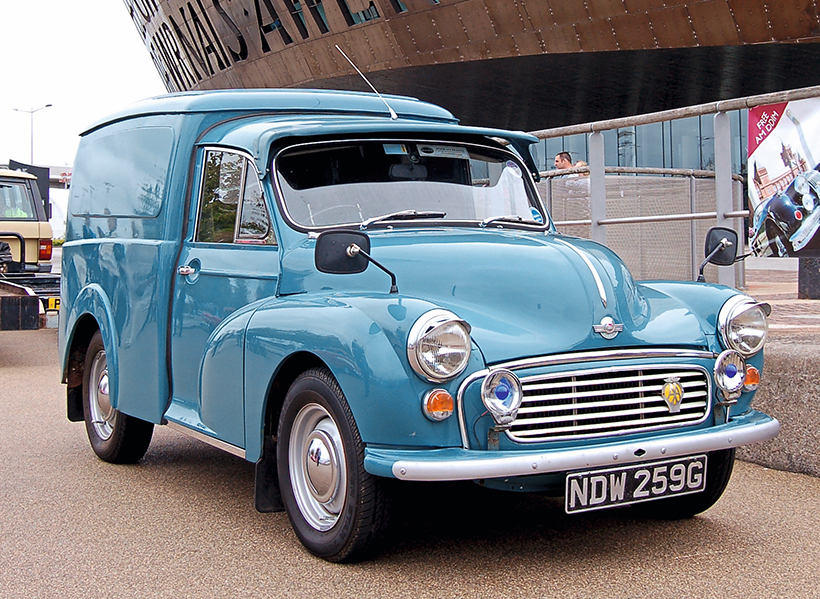
Russ Harvey’s ex-tobacconist Morris Minor 6cwt van dates from 1969.
1962. A 1098cc engine and uprated gearbox were installed, the 5cwt rating lifted to 6cwt and it was designated the series V. Larger rear door windows were used and the front brake drums used increased from 7in to 8in, hubcaps were no longer fitted on GPO vans (cost cutting). A new styled smaller two-spoke steering wheel fitted.

Bob Dunlop’s rare New Zealand conversion, known as a ‘Wilco’, based on a chassis/cab.
1963. Fresh air heater with elephant trunk ducting was introduced, the wiper spindle repositioned and a zone toughened windscreen fitted.
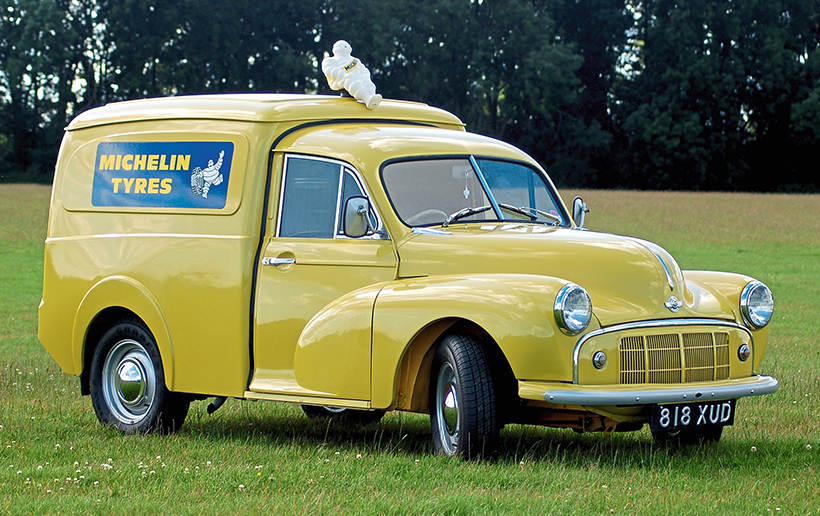
A beautifully-restored series II van in a very striking yellow, ‘Michelin Tyres’ livery.
1964. Large combined flasher and sidelights fitted at front and the round reflector at the rear on the chassis were replaced by an oblong version.
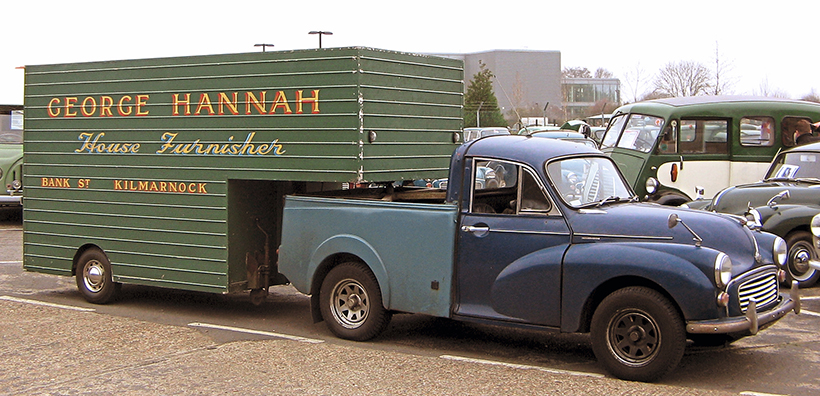
One of only two known ‘Minatic 7s’ to have survived, the BMC trailer provides an articulated Minor. Larger versions were available for many BMC commercials. Both survivors are based in Holland.
1965. A slightly redesigned black facia was used, the speedo included a light to denote blocked oil filter, separate starter button and ignition lock were replaced with all-in-one key starter, wipers and lights operated via flick switches.
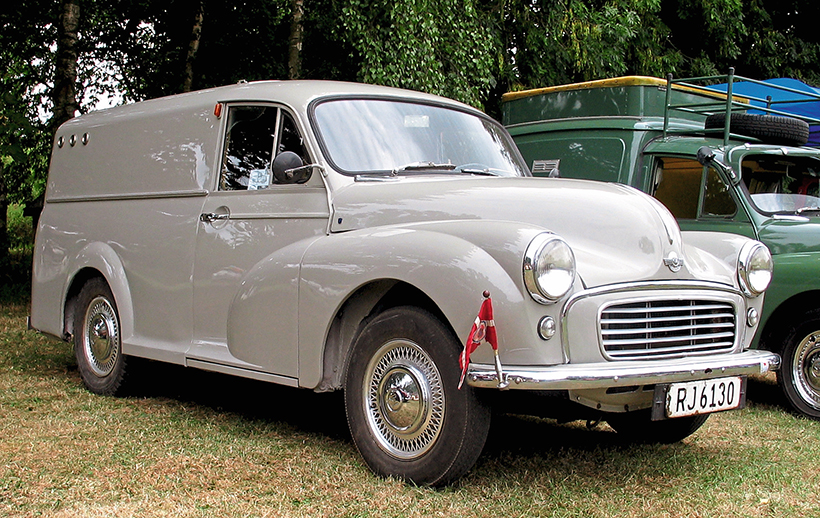
DOMI specially converted van in Denmark, a very rare vehicle, seen at the 50 the celebrations in the UK.
1967. Plain hubcaps were introduced.
1968 onwards. Austin badged models were added to the range, these were designated the Series C, they carried an Austin crinkled grill, Austin bonnet and steering wheel badges, as well as an engine that was painted black. Plain hubcaps were fitted and these were used on both Morris and Austin versions, the larger 4½J wheel rims (LP917) were used for the increased 8 cwt payload versions. A steering lock and ignition switch on steering column were introduced on some late models. Late vans were also fitted with the 11ac alternator using the ‘4tr’ regulator box. Some commercials left the factory without the chrome bonnet flash, by this time the pressing of the centre moulding was worn.
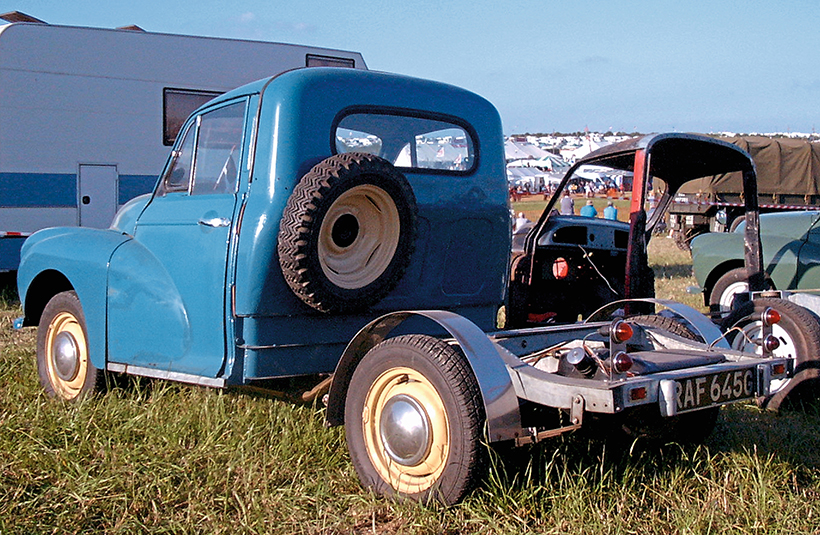
Factory option was a Minor LCV as a chassis/cab with or without the cab back.
The Minor LCV Register caters for the needs of all Minor LCVs (both Austin and Morris) in any condition. The register has over 500 members worldwide and has compiled a database of surviving vehicles. 2023 is the 70th Anniversary of the Minor LCV and to celebrate, they are organising a two-day gathering of Minor LCVs at Coventry Transport Museum 5-6th August, if you own an LCV, we would like to hear from you and would love to have you at the event, but you do need to book as spaces are very limited. For more information contact Russ at the Minor LCV Register, visit their site at www.minorlcvreg.co.uk or contact via email RussLCV@gmail.com

Kim Arne Fjeld’s 1954 series II split-screen van from Norway.

Austin-badged Minor Pick-Up complete with the canvas tilt; the original manufacturer of these covers still exists.
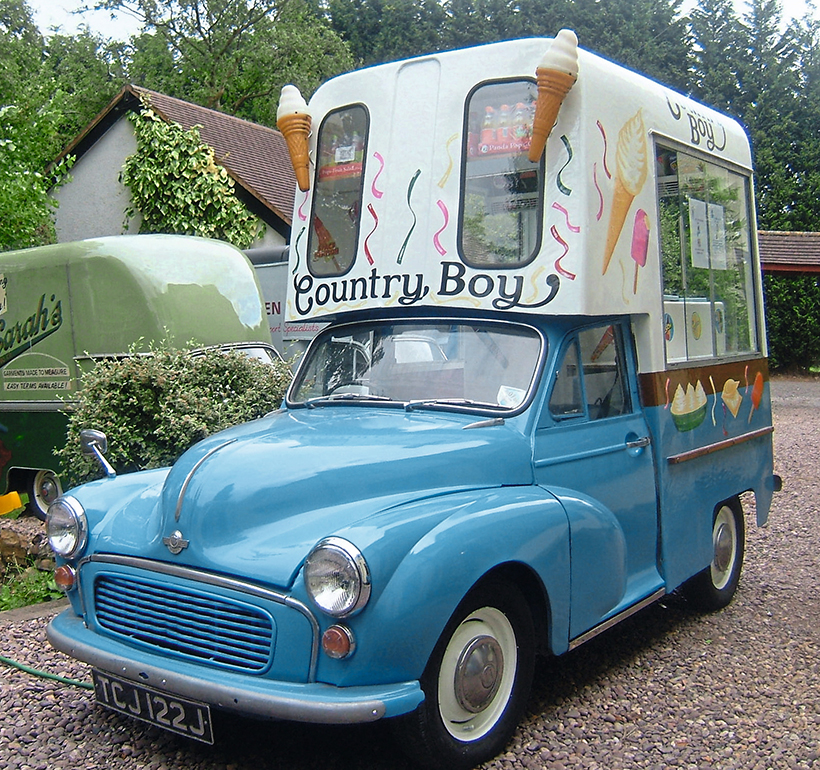
Ice cream van based on a chassis/cab.

Alsop’s Garage, Newport, in 1968, depicts a typical BMC sales forecourt. The four, unregistered Minor vans with a window price of £435 would have made them the more expensive 8-cwt version!
This feature comes from a recent issue of Heritage Commercials, and you can get a money-saving subscription to this magazine simply by clicking HERE
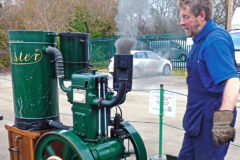
Previous Post
1948 Lister CS diesel engine saved and running again!
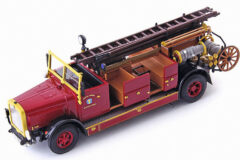
Next Post
The latest diecast and resin models reviewed



